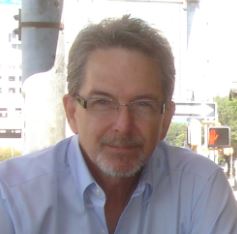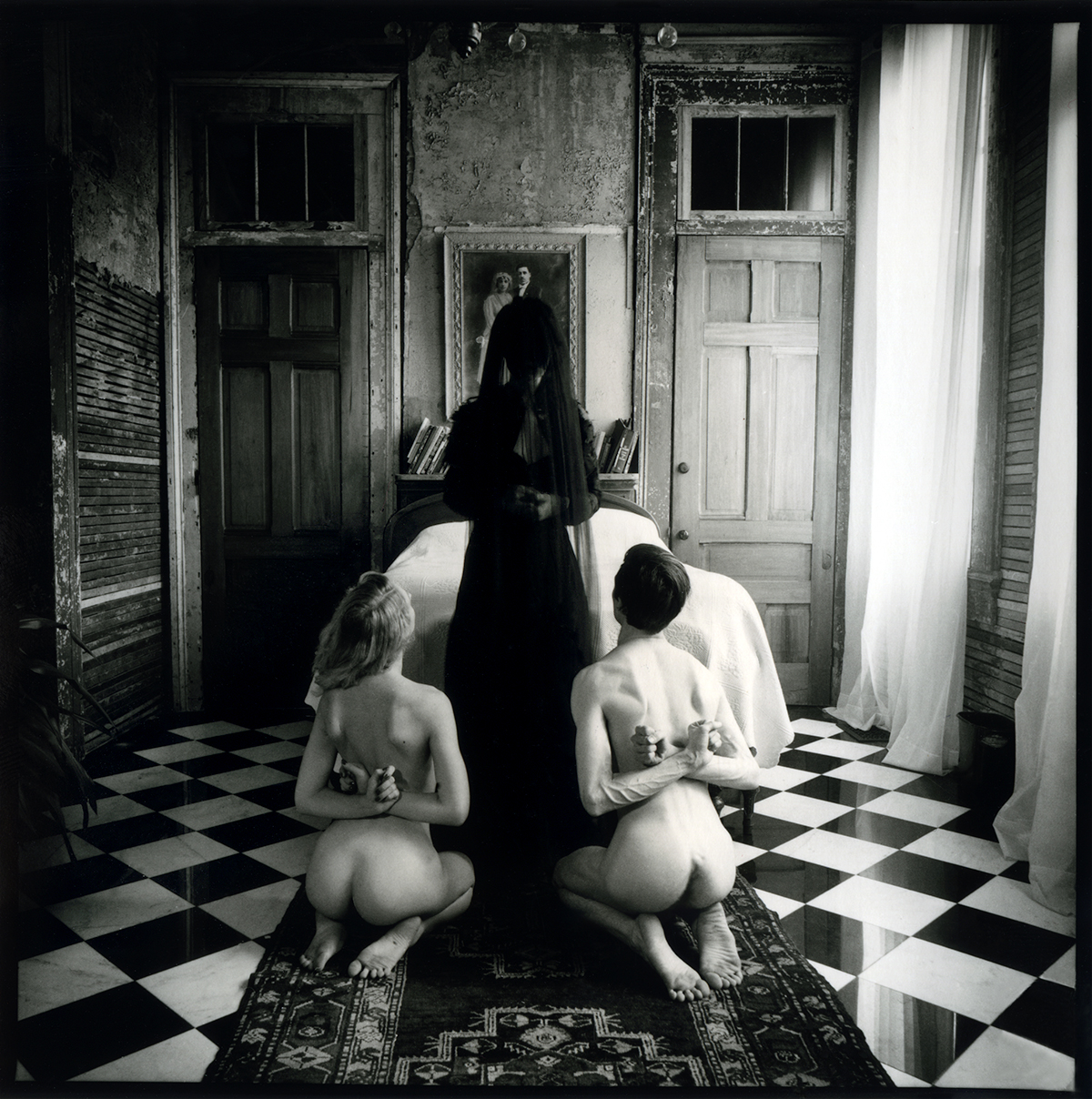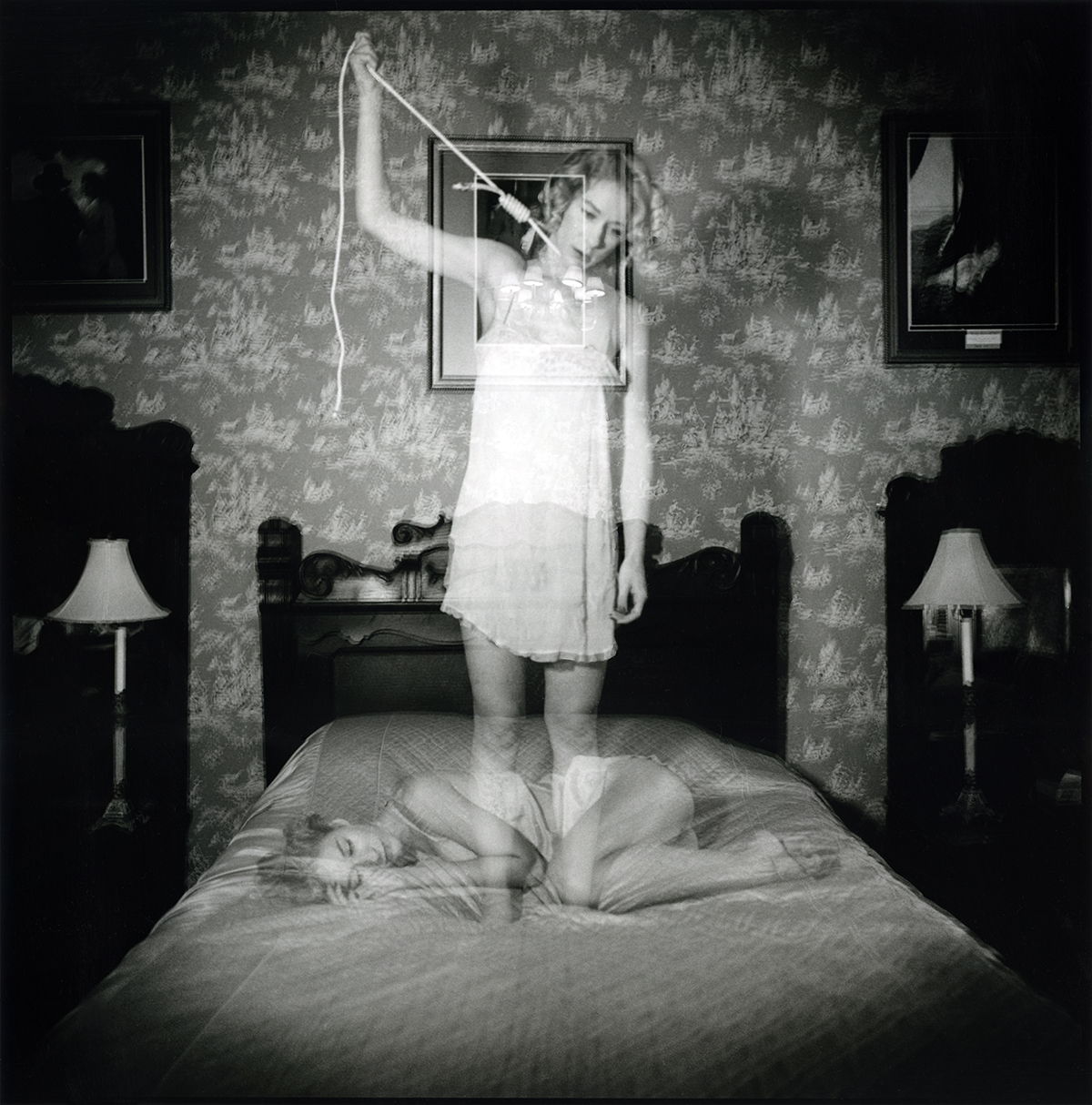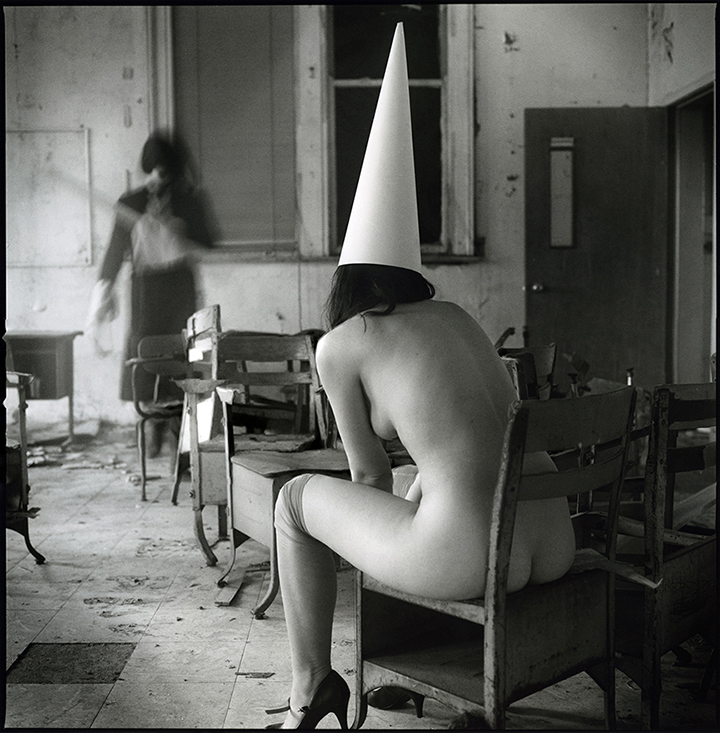©Brittany Markert
The Two Selves (self-portrait) | California | 2014 31815 (self-portrait) | California | 2015
***
Desire, Fear & Triumphs
An interview with photographer Brittany Markert
by Mike Foldes
Founder/Managing Editor
Ragazine: What were your early photographs like, and did you start taking photographs while you were still modeling?
Brittany Markert: In the beginning my work segued from years of modeling and retained a fashion sensibility. I was first inspired by the intimate and fashion photographs of Lina Scheynius and then was introduced to the works of Francesca Woodman, who played a larger part in shaping my understanding of photography and self portraits. The negatives of my early photographs remain in a sealed box hidden in my closet. It is there I wish they remain, unseen!
While modeling I was interested in photography, spending time with artists and taking pictures of my travels, although I wasn’t taking any serious photos.
Ceremony | 2017
How is it that in this age of digital photography you still spend your time in the darkroom?
My darkroom resides 30 feet from my bedroom, this certainly helps! I spend many days frustrated at the patience and costs required with analog photography and printing, but this same patience has become the foundation of creating my artwork. The analog process demands precision, patience, feeling and intention. Each print I decide to show is a unique decisive moment that speaks to something larger than my own voice and is built from start to finish with my hands. I’m not sure if I could achieve the same results another way.
Let Go | 2015
What was the situation that took you to China, how long were you there, and did you do much work there or was it simply a “life experience”?
The year prior to graduating college, I took time off to travel and focus on fashion modeling. I participated in this horrendous show America’s Next Top Model, which gifted me the proper resume to take advantage of traveling all over the world based upon my looks and measurements. I’m not proud of this, but I appreciate the perspective and experiences that shaped my journey into a creative life.
Due to my ‘short height’ there were only a few countries that welcomed me to model full time. Guangzhou, China, was one of these cities and at the time only a short train ride away from my sister studying in Hong Kong. Piled into a van every day, like some sardine waiting for a man in a suit to take a bite, I spent four months there in some kind of existential crisis. With a month left of my contract, I looked into the mirror one day, saw 6-inch stripper shoes, a mini-skirt, hair extensions, a push-up bra, boob cutlets increasing my cleavage, lip gloss, and a painful vapidness. This was not me. I quit going to castings, and driven by some impulse, I traveled to an electronic super mall nearby and bought a tripod. I started taking pictures and told myself I would go home, learn to shoot B&W film, save money and move to New York. No decision after this point has ever been as clear.
Say No | New Orleans | 2015
You went to college in Santa Clara and graduated with a degree in mathematics. Did you grow up in California? How has the thought process of mathematics influenced your photography?
Yes, I was raised in California. I was born in the southern part of the state and moved to the north during high school. This separation is perhaps only relevant to natives, but I attest it’s very serious! Mathematics is a language I understood with ease since childhood and the only subject I cared for growing up. Mathematics is a part of my brain structure and inevitably affects everything I do. I can’t escape the way I process information, store data, interpret values of light and formulate a composition. I understand my approach to a mathematics proof and a photograph very similarly. When spending hours in the library staring at a proof it required years of experiences and data to come to the surface of my mind. I developed an innate ability to navigate through a cloud of chaos to find a solution. In mathematics, of course, there is certainty with a correct answer and proof, but in the same way, however uncertain art is, I believe there is a certainty when one discovers a ‘perfect moment’ captured on film.
Ode To Depression | 2017
Who were your professors at the International School of Photography, and how did one or more of them influence you in the profession?
During my three years of volunteering at the International School of Photography, I only enrolled in two courses. One an introductory course of traditional black and white photography and the other an introduction to color printing. I couldn’t tell you the name of my B&W instructor, but the color was Bill Armstrong. From him, I felt some kind of validation of having my own voice, even though he didn’t outright say it. However, the ‘dry’ color lab was not me at all, hence my decision to work 100 percent in black and white. From my introductory instructor I gained the skills to find my own way around the darkroom, make test strips and begin to understand density of a print. During my years volunteering and printing at ICP I observed many wonderful printers and took notice of Brian Young’s Fine Art Printing course. I was told by many peers that TA-ing or taking the course was an eye opening and necessary experience. Although I did not take the course, nor TA, I observed the course in the darkroom many times and I decided to hire Brian to print some of my work. I was able to spend hours in his private darkroom observing his technique and asking questions. I learned that printing in more simple, straightforward methods would give me much less of a headache and I have since adapted.
Women (self portrait) | New Orleans | 2016
When you are shooting nudes, which appears to be the greater part of your portfolio, how do you dispel or eliminate the tension that can build up between photographer and subject/model?
Nudity is typically present in my shoots, although less lately. I write about this on my website under my artist statement, but the people I work with 95 percent of the time are lovers or kindred spirits. This dynamic alone enables me to create my work under very different circumstances. The tension or desire I experience with those I know is a part of the work, although nudity is not necessarily the reason for creating this tension. Our history, emotions and the overlapping of our minds foster the world of my images. In the rare times that I photograph professional art models or strangers, nudity is usually a part of their portfolio and experiences, so it doesn’t add any tension as you mention. If anything it makes everyone more comfortable and at ease.
Untitled | New York | 2016
There is both humor and wit in many of your images, for instance, Untitled New York, 2016. At first glance it appears to have been taken in the late ‘40s or early ‘50s, and tells a story within a story. How did this staging come to you?
I’m glad you find humor and wit. This project In Rooms leaves little room for my humor since I focus primarily on understanding fear and pain. “Untitled New York, 2016,” or as I sometimes refer to it as ‘storytime’ or ‘femme enfant’, occurred spontaneously within an environment I knew very well. That image carries a great deal of meaning to me and will be the cover of my next book. It is the product of years of experiences, observations and feelings and I prefer if people reach their own idea about it. My interest to photograph scenes dating from the 1950s and prior started as an impulse. After prying into my thoughts, I feel my interest in the past is identifying with the pain, restrictions and repressed thoughts of many women. Some of the pain, fear and anxiety I relate to is rooted in the gender constructs and ill treatment of women in the Victorian era and the idealization of the ‘American family’ and ‘housewives’ of the 1940s/’50s.
Untitled | NewOrleans | 2017
What prompts you to set up and create your scenes as you do? Do you work with stylists?
My scenes are the results of following a path of euphoria, and waiting patiently until I am excited about everything involved — the people, the location, the props and most importantly, the energy and emotions present. This is the die-hard romantic in me, letting love and feelings guide my inspiration. Sometimes I wait as long as three months for the perfect energy and circumstances to make a picture. I am inspired by theatre, literature, films and daydreams, to name a few, and want my work to have a narrative sensibility acted out in familiar or dreamlike structures.
I do not work with a stylist ninety-five percent of the time because I don’t have a budget, which is why there is a lot of nudity in my work. Sometimes I have the fortunate pleasure to work with people that own wonderful clothing, props and contribute these items to my work. In 2017, I started working with a magnificent stylist and friend Candice Guttman, and hope to continue making work with her as I find more time in New York.
Untitled | Louisiana | 2015
Were you given a lot of freedom as a child? Were or are your parents artists or writers?
An interesting question as I write this article in France while spending time with my family. As a child I was very blessed, the boundaries of what I could watch on television, what I could eat, and what activities I could partake in were strict, but the limits of my imagination were never stunted. In this way I had complete freedom. I could dress myself as I pleased, be whatever character I wanted for Halloween, read whatever genre of books my heart desired and take on the masculine identity of ‘J.J’ around the house if I pleased. I told my mother I was not a ‘fufu princess’ in kindergarten and she fostered a childhood in which I could express myself fully. Everything felt possible in my mind, my parents never made me feel ashamed by my fantastical desires to dress as a villain, be a ‘boy’, watch horror films, wear shoe laces in my hair, quit dancing to do sports, etc. They encouraged me to be myself and I owe them so much for enabling me to feel confident and strong by following a life of passion.
My parents and extended family are not artists. I had no role model growing up that was an artist and did not have a childhood going to museums, galleries and being aware of the “art world”. My mother suggested that I go to an artistic high school and I recall feeling that she was utterly mad because I was “supposed to be” a CEO or Doctor or Teacher. I believe at the time I thought art school was cutting up and gluing paper to other pieces of paper and perhaps even coloring.
Menage A Trois | New Orleans | 2016
Is there anything you would like to say or add that we did not cover here?
My current book, In Rooms Volume 2 (2016-2017), is finishing up production in December of 2017 and is available to pre-order on my website. I have spent the last four years dedicating my life to art and creating these books and am excited about the release of this volume. When I am inspired by an artist I love the experience of reading their personal words, and learning about their lives and inner dialogue. I wanted to provide others with this opportunity to engage with an artist’s work and life in a personal way in order to provide inspiration and hope. The images are presented in chronological order, to maintain a diary-like feel and present the passing of time amongst the same characters. The second volume provides an intimate look into the mind of a woman, her desires, fears, triumphs and struggles. With the addition of hand-written text on all pages and a supplemental series of personal “diary work” with hand entries, the viewer can more closely experience the creation of my art amidst my reality. Included is also a special section of behind the scenes journal entries and contact sheets. To find more information feel free to check out www.InRoomsGallery.com and my Indiegogo campaign
After the book is released I plan to tour it along with work around the USA and a few locations in Europe. Information will be available on my social media accounts (IG: @in_rooms) and my website www.in-rooms.com.
Untitled | New Orleans | 2016
How has New Orleans, wild and wonderful as it can be, influenced your work? And WHY New Orleans in the first place?
Why New Orleans is a question I think about often. I started visiting New Orleans in December of 2014 after a surreal invitation from a friend. I was literally pulled out of my life in New York with 10 hours’ notice and planted in New Orleans with zero plans or friends in the city. I don’t believe in coincidences, and knew this journey would change my life somehow. Ironically I disliked so much about the city, but this weekend marked a time when my work started to take off and I met a muse who would become my partner and confidante to all my artistic ideas. As much as I disliked New Orleans (the tourism, smells, weather, pace, limited resources) and couldn’t imagine living there, I spent three months out of 2015 there and made some of my best work.
As many New Orleanians can attest, there is something about the city that gets under your skin. The energy and history of the city is rooted deeply with pain, mystery and magic and the aesthetic carries a beautiful decaying glimpse of the past. These qualities allow my work to thrive. I miss New York daily. My time living there couldn’t have been more of a fairy tale that artists dreams of, but I was greatly bothered more and more by the facade of the people in the city and the ways of life governed by shallow business relationships, ego and extreme wealth. While living in New York I found myself spending a lot of time traveling upstate or to Connecticut to reset my mind. New Orleans offers the mindset of ‘being upstate’ without the need to be completely self sufficient and able to handle the winters alone and isolated. I refer to New Orleans as ‘The Island of Misfit Toys’ and the sense of community for us all is very strong. The people of New Orleans are real and community oriented, they have been through hell and back and wear their pain on their sleeves.
Ultimately I needed space, a kind community and solitude in an environment that suited my imagination, while having access to a “city life” and basic necessities. My place in New Orleans is a Victorian shotgun with soaring 14-foot ceilings, turn-of-the-century mahogany flamed furniture with a decaying studio room and darkroom. The house feels like walking one of my photographs while also having functional room for a work space. There is utmost quiet every day, and hours spent collecting my thoughts while listening to thunder and rain slapping against the windows. If I leave my bubble I am within blocks of restaurants, bars, parks and anything I could really need. Did I mention my rent is half of New York? For now, New Orleans is my home and has given me the space to build the next chapter of my work and further develop my style technically. While New York stroked my ego, made me look good from the outside and quickly forced me to develop my craft and survive while finding the most beautiful and talented friendships and collaborators, New Orleans has provided a safe shelter in which I could deeply look within and grow into the self I was meant to be, not the self others desired or expected of me. Ideally I will find time between New Oreans, New York and perhaps Berlin after I close this next chapter of In Rooms this December.
All photographs used by permission and copyrighted© by Brittany Markert
This e-interview with Brittany Markert was conducted in October-November 2017.
About the interviewer:
 Mike Foldes is founder and managing editor of Ragazine.CC. You can read more about him in About Us.
Mike Foldes is founder and managing editor of Ragazine.CC. You can read more about him in About Us.
















Recent Comments